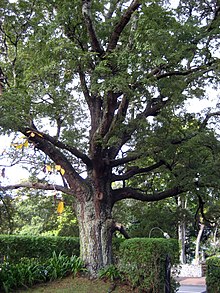|
Nothofagus solandri
Nothofagus solandri, commonly called black beech, is species of tree endemic to New Zealand. Black beech occurs on both the North and the South Island at low elevations up to the mountains. It is also known as Nothofagus solandri var. solandri. In New Zealand the taxon is often called Fuscospora solandri.[3] Black beech is a medium-sized evergreen tree growing to 27 m tall. The leaves are oppositely arranged, ovoid, 10 mm long and 5 mm broad, with smooth margins. Black beech is known as black beech because it is prone to a sooty mold which covers the trunk and branches. This, in turn, is the result of a scale insect which sucks sap from the tree, and excretes honeydew, a sweet liquid, in small droplets (less than 1 mm diameter) on the end of stalks. This feeds the sooty mold, and also forms a valuable high-energy food source for various birds and insects including the kaka. The infestation is common and does not appear to harm the tree. Black beech and mountain beech have both been planted in Great Britain, and mountain beech has shown better cold tolerance than black beech in locations such as Scotland.[4] Hybrids
References
External links
|
||||||||||||||||||||||||||||||||||||||

